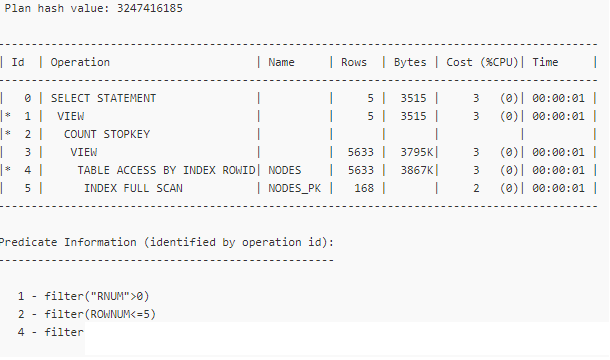An ancient "issue" that is still with us, even in 18.4
SQL> select banner_full from v$version;
BANNER_FULL
------------------------------------------------------------
Oracle Database 18c Enterprise Edition Release 18.0.0.0.0 -
Production
Version 18.4.0.0.0
SQL> create table t1 as select * from dba_objects where object_id is not null;
Table created.
SQL> alter table t1 add constraint t1_pk primary key (object_id);
Table altered.
SQL> exec dbms_stats.gather_table_stats(user, 'T1', cascade=>true);
PL/SQL procedure successfully completed.
SQL> explain plan for select * from (select * from t1 order by object_id) where rownum <= 5;
Explained.
SQL> select * from table(dbms_xplan.display);
PLAN_TABLE_OUTPUT
----------------------------------------------------------------------------------------------------
Plan hash value: 3766500789
---------------------------------------------------------------------------------------
| Id | Operation | Name | Rows | Bytes | Cost (%CPU)| Time |
---------------------------------------------------------------------------------------
| 0 | SELECT STATEMENT | | 5 | 2405 | 3 (0)| 00:00:01 |
|* 1 | COUNT STOPKEY | | | | | |
| 2 | VIEW | | 5 | 2405 | 3 (0)| 00:00:01 |
| 3 | TABLE ACCESS BY INDEX ROWID| T1 | 62395 | 7616K| 3 (0)| 00:00:01 |
| 4 | INDEX FULL SCAN | T1_PK | 5 | | 2 (0)| 00:00:01 |
---------------------------------------------------------------------------------------
Predicate Information (identified by operation id):
---------------------------------------------------
1 - filter(ROWNUM<=5)
16 rows selected.
The above is kind of explainable, but this is where the numbers get strange (3670 comes from num_rows/num_distinct):
SQL> explain plan for select * from (select * from t1 where owner = 'SYS' order by object_id) where rownum <= 5;
Explained.
SQL> select * from table(dbms_xplan.display);
PLAN_TABLE_OUTPUT
----------------------------------------------------------------------------------------------------
Plan hash value: 3766500789
---------------------------------------------------------------------------------------
| Id | Operation | Name | Rows | Bytes | Cost (%CPU)| Time |
---------------------------------------------------------------------------------------
| 0 | SELECT STATEMENT | | 5 | 2405 | 5 (0)| 00:00:01 |
|* 1 | COUNT STOPKEY | | | | | |
| 2 | VIEW | | 6 | 2886 | 5 (0)| 00:00:01 |
|* 3 | TABLE ACCESS BY INDEX ROWID| T1 | 3670 | 447K| 5 (0)| 00:00:01 |
| 4 | INDEX FULL SCAN | T1_PK | 102 | | 2 (0)| 00:00:01 |
---------------------------------------------------------------------------------------
Predicate Information (identified by operation id):
---------------------------------------------------
1 - filter(ROWNUM<=5)
3 - filter("OWNER"='SYS')
17 rows selected.
rownum implicitly triggers some first_rows_N optimization that messes up the cardinality (this was discussed on Oracle-l, 12 years ago: https://www.freelists.org/post/oracle-l/ORDER-BY-and-first-rows-10-madness,4). One workaround is to run it with all_rows hint (yes, even if it is the current setting in the session), also I had to place the hint for the index, otherwise the database would have chosen FTS in this example:
SQL> explain plan for select /*+ all_rows */ * from (select /*+ index(t1 t1_pk) */ * from t1 order by object_id) where rownum <= 5;
Explained.
SQL> select * from table(dbms_xplan.display);
PLAN_TABLE_OUTPUT
----------------------------------------------------------------------------------------------------
Plan hash value: 3766500789
---------------------------------------------------------------------------------------
| Id | Operation | Name | Rows | Bytes | Cost (%CPU)| Time |
---------------------------------------------------------------------------------------
| 0 | SELECT STATEMENT | | 5 | 2405 | 1459 (1)| 00:00:01 |
|* 1 | COUNT STOPKEY | | | | | |
| 2 | VIEW | | 62395 | 28M| 1459 (1)| 00:00:01 |
| 3 | TABLE ACCESS BY INDEX ROWID| T1 | 62395 | 7616K| 1459 (1)| 00:00:01 |
| 4 | INDEX FULL SCAN | T1_PK | 62395 | | 131 (1)| 00:00:01 |
---------------------------------------------------------------------------------------
Predicate Information (identified by operation id):
---------------------------------------------------
1 - filter(ROWNUM<=5)
16 rows selected.
Much better. Another reason to use analytic functions or the 12c+ syntax instead of rownum. Analytic function:
SQL> explain plan for select * from (select t1.*, row_number() over (order by object_id) as rn from t1) where rn <= 5;
Explained.
SQL> select * from table(dbms_xplan.display);
PLAN_TABLE_OUTPUT
---------------------------------------------------------------------------------------
Plan hash value: 3641836603
---------------------------------------------------------------------------------------
| Id | Operation | Name | Rows | Bytes | Cost (%CPU)| Time |
---------------------------------------------------------------------------------------
| 0 | SELECT STATEMENT | | 5 | 2470 | 1459 (1)| 00:00:01 |
|* 1 | VIEW | | 5 | 2470 | 1459 (1)| 00:00:01 |
|* 2 | WINDOW NOSORT STOPKEY | | 62395 | 7616K| 1459 (1)| 00:00:01 |
| 3 | TABLE ACCESS BY INDEX ROWID| T1 | 62395 | 7616K| 1459 (1)| 00:00:01 |
| 4 | INDEX FULL SCAN | T1_PK | 62395 | | 131 (1)| 00:00:01 |
---------------------------------------------------------------------------------------
Predicate Information (identified by operation id):
---------------------------------------------------
1 - filter("RN"<=5)
2 - filter(ROW_NUMBER() OVER ( ORDER BY "OBJECT_ID")<=5)
17 rows selected.
Or 12c+ syntax:
SQL> explain plan for select * from t1 order by object_id fetch first 5 rows only;
Explained.
SQL> select * from table(dbms_xplan.display);
PLAN_TABLE_OUTPUT
---------------------------------------------------------------------------------------
Plan hash value: 3641836603
---------------------------------------------------------------------------------------
| Id | Operation | Name | Rows | Bytes | Cost (%CPU)| Time |
---------------------------------------------------------------------------------------
| 0 | SELECT STATEMENT | | 5 | 2535 | 1459 (1)| 00:00:01 |
|* 1 | VIEW | | 5 | 2535 | 1459 (1)| 00:00:01 |
|* 2 | WINDOW NOSORT STOPKEY | | 62395 | 7616K| 1459 (1)| 00:00:01 |
| 3 | TABLE ACCESS BY INDEX ROWID| T1 | 62395 | 7616K| 1459 (1)| 00:00:01 |
| 4 | INDEX FULL SCAN | T1_PK | 62395 | | 131 (1)| 00:00:01 |
---------------------------------------------------------------------------------------
Predicate Information (identified by operation id):
---------------------------------------------------
1 - filter("from$_subquery$_002"."rowlimit_$$_rownumber"<=5)
2 - filter(ROW_NUMBER() OVER ( ORDER BY "T1"."OBJECT_ID")<=5)
17 rows selected.

